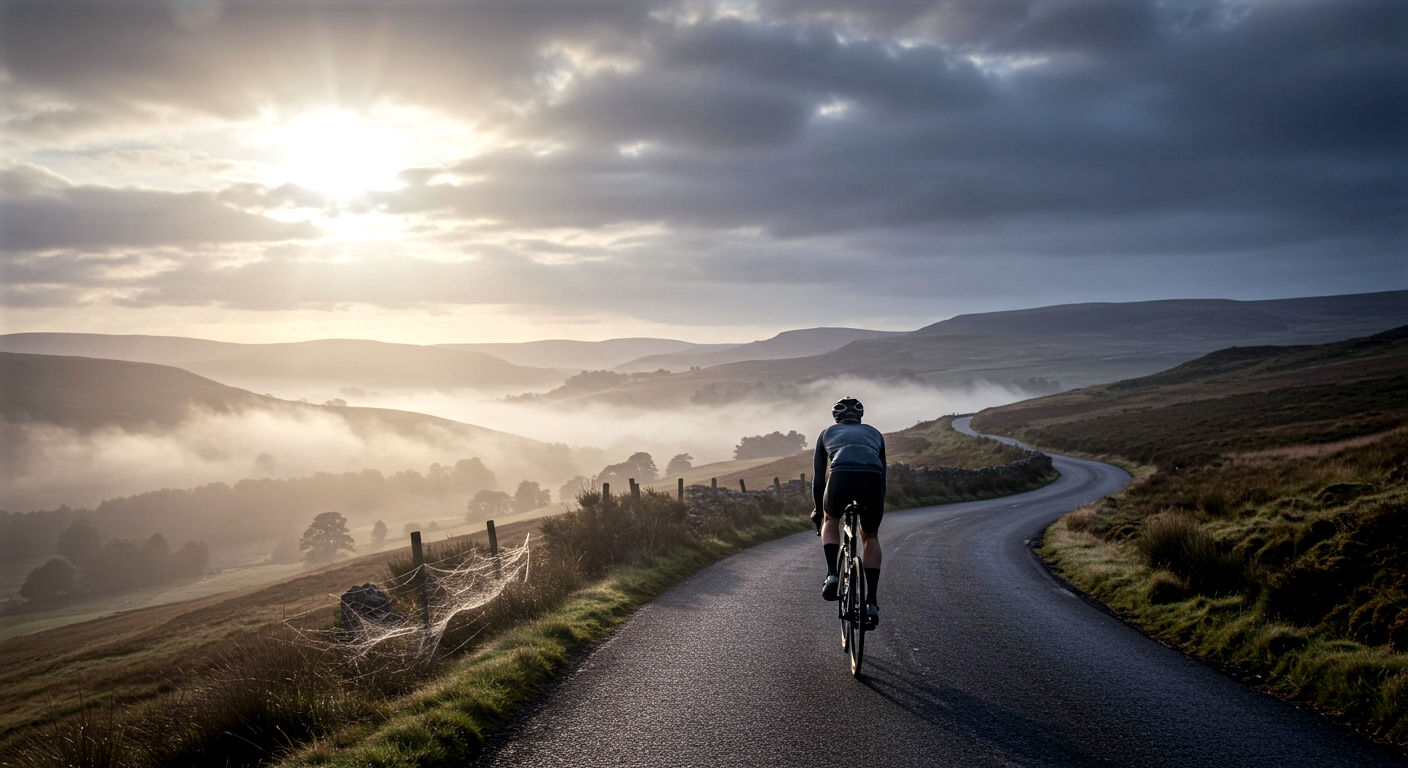From Pootles to Peaks: The Ultimate British Guide to Bicycle Activewear
Unlock comfort and performance on your bike. This ultimate guide breaks down everything about cycling activewear, from the science of Lycra to layering for a wet British winter.

This post may contain affiliate links. If you make a purchase through these links, we may earn a commission at no additional cost to you.
Picture this: a cyclist glides along a winding lane in the Peak District. The air is crisp, the famous British drizzle has just subsided, and steam rises from the damp tarmac as the sun breaks through. They’re not wearing a cotton t-shirt and jeans. They’re clad in sleek, form-fitting fabrics that seem to shrug off the weather. This isn’t just about looking the part of a pro; it’s about comfort, performance, and honestly, the sheer joy of riding a bike without feeling cold, soggy, or horribly chafed.
Welcome to the world of bicycle activewear, or as most of us call it, ‘cycling kit’. For the uninitiated, it can seem like a daunting universe of baffling jargon and eye-watering price tags. Bib shorts? Chamois? Wicking? Is it all just a way to sell us expensive Lycra?
The short answer is no. This guide is here to demystify the cyclist’s wardrobe. We’ll take you from the very basics of why you can’t just cycle in your running gear, through the history of how we got from tweed jackets to technical fabrics, and provide a head-to-toe breakdown of what you actually need. Whether you’re planning a gentle Sunday pootle along the canal, commuting through London, or tackling an epic sportive in the Highlands, understanding your kit is the key to unlocking a better ride. Consider this your definitive map to navigating the world of cycling clothing.
Why Bother with Special Kit? The Science of Comfort and Speed
Before we dive into the specifics, let’s tackle the big question: why can’t you just use your normal gym clothes? The answer lies in the unique demands of cycling. You’re in a fixed, hunched position for hours, generating heat and sweat, all while battling the elements. Your gym shorts just weren’t designed for that.
It’s Not Just About Looking the Part: Function Over Fashion
The first rule of cycling kit is that every single feature has a purpose. The snug fit isn’t for vanity; it’s to stop fabric flapping in the wind, which slows you down and can be incredibly annoying. The weird-looking padding in the shorts isn’t a fashion statement; it’s your best friend after an hour in the saddle. The long back and short front of a jersey aren’t a manufacturing error; they’re designed for a forward-leaning riding position.
The Big Three: Wicking, Padding, and Aerodynamics
If you take away nothing else, remember these three core principles of good cycling kit.
- Moisture Wicking: This is perhaps the most crucial job of cycling activewear. When you exercise, you sweat. If that sweat sits on your skin, it makes you cold when you stop or ride downhill. Cotton is a cyclist’s worst enemy because it acts like a sponge, getting heavy and cold. Modern cycling fabrics, however, are designed to ‘wick’ sweat away from your skin to the outer surface of the material, where it can evaporate. This keeps you dry, comfortable, and at a much more stable temperature.
- Padding and Protection: The main contact points between you and your bike are your hands, your feet, and your backside. Cycling kit is designed to protect them. Padded shorts (with a ‘chamois’) reduce pressure and prevent chafing on your sit bones. Padded gloves absorb road vibrations, preventing numb hands. And stiff-soled shoes ensure all your power goes into the pedals, not into flexing your trainers.
- Aerodynamics: While it might not feel important when you’re cycling to the local shop, air resistance is the biggest force a cyclist has to overcome. Even a slightly baggy jacket acts like a parachute, making you work harder to maintain the same speed. A close fit minimises this drag, making your ride easier and faster. For professional riders, this is an obsession, but even for us mortals, it makes a noticeable difference.
A Spin Through Time: The Evolution of Cycling Attire
Today’s cyclist, clad in high-tech synthetics, is a world away from the pioneers of the sport. The journey from heavy wool to lightweight Lycra is a story of innovation, driven by the desire to ride further and faster.
From Tweed Jackets to Woollen Wonders
In the late 19th and early 20th centuries, cyclists wore what was considered sporting attire at the time: tweed jackets, plus-fours, and sturdy leather shoes. It was heavy, restrictive, and became incredibly waterlogged in the rain.
The first real step forward came with the use of wool. Unlike cotton, wool retains some of its insulating properties even when wet, and it’s naturally breathable. For decades, the professional peloton, including legends of the Tour de France, raced in simple woollen jerseys and shorts. These jerseys often had button-up pockets on the front for carrying food. The shorts offered little in the way of padding, with riders relying on a piece of soft leather (a real chamois leather, from the mountain goat of the same name) sewn into the shorts to reduce friction. It was better than nothing, but it was far from comfortable.
The Lycra Revolution: A Game Changer
The real transformation happened in the late 1970s and early 1980s. The invention of synthetic, stretchy fabrics like Lycra (also known as spandex) changed everything. A small Italian company called Castelli was among the first to introduce Lycra shorts to the pro peloton.
At first, riders were sceptical. The skin-tight look was radical. But the benefits were undeniable. Lycra offered incredible freedom of movement, it was lightweight, it dried quickly, and its compressive qualities were found to support the muscles. Combined with the development of synthetic, multi-density foam pads to replace the simple leather chamois, cycling shorts became infinitely more comfortable. The era of the modern cycling kit had begun.
The Rise of the Pro Peloton Style
As television coverage of races like the Tour de France grew, the look of the professional cyclist became iconic. Brightly coloured jerseys covered in sponsors’ logos became the norm. Fans wanted to emulate their heroes, and a huge market for replica team kits was born. This drove further innovation in fabrics, fit, and design, trickling down from the pro teams to the everyday rider.
The Cyclist’s Wardrobe: A Head-to-Toe Breakdown
Building a cycling wardrobe can feel overwhelming. Let’s break it down into the essential components, explaining what they do and what to look for.
The Jersey: Your Second Skin
A cycling jersey is the cornerstone of your upper body kit. It’s fundamentally different from a regular t-shirt.
- The Cut: It’s longer at the back to ensure your lower back is covered when you’re leaning forward, and shorter at the front to prevent fabric from bunching up around your stomach.
- The Pockets: Almost all jerseys have three deep pockets on the lower back. This is a design masterpiece. It allows you to easily carry essentials like a spare inner tube, a small pump, your phone, and some food without needing a rucksack, which would make your back sweaty.
- The Zip: A full-length zip at the front is a brilliant feature for regulating your temperature. Feeling too hot on a long climb? Zip it down. Getting chilly on the descent? Zip it right up.
- The Material: Made from a wicking polyester fabric, it pulls sweat away from your body to keep you dry.
The Shorts (or Bibs): The Unsung Hero of Cycling
If you invest in one single piece of quality kit, make it your shorts. Nothing will end a ride quicker than discomfort in the saddle.
To Bib or Not to Bib? That is the Question.
You have two main choices: shorts or bib shorts.
- Waist Shorts: These are like regular shorts, held up by an elasticated waistband. They’re simpler to get on and off, which is handy for quick comfort breaks.
- Bib Shorts: These are held up by two straps (the ‘bibs’) that go over your shoulders, a bit like braces. The vast majority of serious cyclists prefer bibs, and for good reason. They eliminate the waistband, which can dig in and feel restrictive. More importantly, the straps hold the padded insert (the chamois) perfectly in place, preventing it from moving around and causing chafing. They are, without a doubt, the more comfortable option for any ride longer than a quick dash to the shops.
A crucial tip: You do not, under any circumstances, wear underwear with padded cycling shorts. The chamois is designed to sit directly against your skin. The seams on underwear will rub and cause the very chafing and soreness you’re trying to prevent. Trust us on this.
Understanding the Chamois (It’s Not a Mountain Goat)
The pad inside your shorts is called a chamois (pronounced ‘sham-wah’). The name is a throwback to when it was made of leather, but modern pads are miracles of foam engineering.
A good chamois will have:
- Varying Densities: Thicker padding under your sit bones where the pressure is highest, and thinner foam elsewhere to reduce bulk.
- Seamless Construction: To prevent any rubbing.
- Anatomical Shape: Men’s and women’s chamois pads are shaped differently to suit their respective anatomies. It’s vital to buy gender-specific shorts for maximum comfort.
- Antibacterial Properties: To keep things hygienic on long, sweaty rides.
The Base Layer: The Secret to Staying Dry
A base layer is a thin, skin-tight top worn underneath your jersey. It might seem odd to add a layer on a warm day, but its job isn’t primarily to add warmth; it’s to manage moisture. It acts as the first line of defence, wicking sweat away from your skin even more effectively than a jersey can on its own. In winter, a thicker, thermal base layer (often made of Merino wool) does the same job while also trapping a layer of warm air. Think of it as the string vest of the 21st century—a surprisingly effective secret weapon for all-year comfort.
The Outer Layers: Your Shield Against the British Weather
Living in the UK means being prepared for four seasons in one day. Your outer layers are what make cycling a year-round possibility.
Gilets and Windproofs
A gilet (pronounced ‘jee-lay’) is a sleeveless jacket. It’s a fantastically versatile piece of kit. It keeps your core warm by blocking the wind but allows your arms to breathe, preventing you from overheating. They are usually lightweight and can be easily packed down into a jersey pocket, making them perfect for cool starts or long descents. A full windproof jacket does the same job but with sleeves for extra protection.
The All-Important Waterproof Jacket
A good waterproof is non-negotiable for any British cyclist. But not all waterproofs are created equal. You need one that is not only waterproof but also breathable. A cheap, non-breathable jacket is like cycling in a bin bag—it will keep the rain out, but you’ll soon be just as wet from your own sweat on the inside. Look for jackets made with advanced membranes like Gore-Tex or similar proprietary fabrics that have microscopic pores large enough to let water vapour (sweat) out, but small enough to stop water droplets (rain) from getting in.
The Extremities: Gloves, Socks, and Overshoes
- Gloves (or Mitts): In summer, fingerless mitts with padded palms absorb road buzz and protect your hands if you fall. In winter, full-finger, insulated, and often waterproof gloves are essential to prevent your fingers from going numb.
- Socks: Just like with jerseys, avoid cotton. Cycling socks are thin, made from wicking materials, and come in a variety of lengths to satisfy the style police. In winter, thicker Merino wool socks are a godsend.
- Overshoes: These are waterproof and windproof covers that go over your cycling shoes. In the cold and wet, they are transformative, keeping your feet warm and dry when the rest of the world is a puddle.
The Material World: What Your Kit is Actually Made Of
The performance of your activewear comes down to the clever fabrics it’s made from. Understanding the basics will help you choose the right gear.
Synthetic Saviours: Lycra, Polyester, and Nylon
This family of man-made fabrics forms the backbone of modern cycling wear.
- Polyester: The workhorse of the cycling jersey. It’s brilliant at wicking moisture, dries incredibly fast, and is very durable.
- Lycra (Elastane/Spandex): This provides the all-important stretch in shorts and jerseys, allowing for a close, aerodynamic fit without restricting movement. It’s almost always blended with other fibres.
- Nylon (Polyamide): Often used in shorts and jackets because of its exceptional durability and abrasion resistance.
The Magic of Merino: Nature’s Technical Fabric
Merino wool is a superstar material, especially for base layers and winter kit. It comes from the Merino sheep and has superfine fibres that don’t itch like traditional wool. Its properties are amazing:
- It wicks moisture well.
- It’s incredibly breathable.
- It’s naturally odour-resistant (unlike synthetics, which can get smelly).
- Crucially, it continues to insulate even when it gets damp.
Weatherproof Wonders: Membranes Like Gore-Tex
The secret to a good waterproof and breathable jacket lies in a special membrane laminated between an inner and outer fabric. The most famous is Gore-Tex.
- Simplified Explanation: Imagine a material with over a billion tiny holes per square centimetre. Each hole is 20,000 times smaller than a water droplet, so rain can’t get in. But each hole is also 700 times larger than a molecule of water vapour, so sweat can easily escape.
- Detailed Explanation: The membrane is made from expanded polytetrafluoroethylene (ePTFE). It’s a microporous material that is inherently hydrophobic (it repels water). Some versions also have a hydrophilic (water-attracting) polyurethane layer that helps pull moisture away from the body. This combination creates a garment that is durably waterproof, windproof, and breathable.
Dressing for the Ride: A Practical Guide for British Cyclists
Knowing what kit exists is one thing; knowing what to wear and when is another.
The Art of Layering: The Onion Principle
The key to all-weather cycling comfort is layering. This allows you to adapt to changing conditions by adding or removing items. A typical three-layer system for a cool day would be:
- Base Layer: Wicks sweat off your skin.
- Mid Layer (Jersey): Provides insulation and continues to move moisture outwards.
- Outer Layer (Gilet or Jacket): Protects you from the wind and rain.
It’s always better to start a ride feeling slightly cool, as you’ll warm up within ten minutes. If you’re warm from the moment you set off, you’ll be overheating and sweating buckets before you’ve left your own village.
A Year in Kit: Dressing for the Four Seasons (in One Day)
- Summer (18°C+): Short-sleeved jersey, bib shorts, mitts, and socks. Simple.
- Spring/Autumn (8-17°C): This is where layering is king. You might start with a base layer, jersey, bib shorts, and add arm warmers and leg warmers (removable sleeves and leggings). A packable gilet or lightweight jacket in your pocket is a very smart move.
- Winter (0-7°C): Don’t be afraid to get out there! The key is blocking wind and trapping warm air. You’ll need a thermal long-sleeved base layer, fleece-lined (roubaix) bib tights instead of shorts, a thermal, windproof softshell jacket, warm gloves, a hat under your helmet, and thermal overshoes.
Kit for Your Tribe: Road, Mountain, Gravel, and Commute
While the core principles are the same, different types of riding have slightly different clothing needs.
- Road Cycling: The focus is on a tight, aerodynamic fit to maximise speed and efficiency.
- Mountain Biking (MTB): Kit is much looser and more durable. You’ll see baggy shorts worn over padded liners and tougher jerseys to resist snags from branches. Protection, like knee pads, is also common.
- Gravel Riding: This is a hybrid. The kit often blends the snug fit of road cycling with the ruggedness of MTB gear. You might see more pockets for carrying supplies on long adventures and more muted, earthy colours.
- Commuting: The priority is practicality and visibility. Commuter gear often has lots of reflective details, a more relaxed fit so you can wear it in the office, and enhanced waterproofing for the daily grind.
Beyond the Bike: The Culture and Controversies of Cycling Kit
Cycling activewear isn’t just functional; it’s a core part of cycling culture.
The MAMIL Phenomenon: A British Icon?
The acronym MAMIL (Middle-Aged Man In Lycra) entered the Oxford English Dictionary in 2012. It describes a common sight on British roads: men of a certain age, rediscovering a love for cycling, kitted out in expensive team replica gear. While sometimes used humorously (or pejoratively), the MAMIL represents a huge part of the UK’s cycling boom, driving the market for high-performance activewear and proving that the joy of cycling is for everyone.
Style on Two Wheels: From Performance to Fashion
In recent years, cycling kit has become increasingly style-conscious. Brands like the British-based Rapha have built an empire on minimalist designs, high-quality materials, and a brand image that sells a lifestyle, not just a product. The line between high-performance sportswear and fashion has blurred, with aesthetics now almost as important as aerodynamics for many riders.
The Sustainability Question: Can Cycling Kit Be Green?
The cycling industry has a problem. Most high-performance kit is made from petroleum-based synthetic fibres. There is a growing movement towards sustainability, with more brands using recycled polyesters, developing plant-based alternatives, and offering repair services to extend the life of their garments. When you buy, consider brands with strong environmental credentials—it’s a small way to help protect the beautiful landscapes we love to ride through.
The Future is Fast (and Smart): What’s Next for Bicycle Activewear?
The evolution of cycling kit is far from over. We’re on the cusp of some exciting developments.
Smart Fabrics and Integrated Tech
Imagine a jersey with integrated sensors that can monitor your heart rate, body temperature, and hydration levels, sending data directly to your bike computer. Or fabrics with woven-in lights that improve your visibility without needing batteries. This technology is already in development and will likely become more mainstream.
Customisation and 3D Printing
We may see a future where kit is no longer sold in standard small, medium, and large sizes. Instead, you could get a 3D body scan and have garments printed or knitted to your exact measurements, providing a perfect, bespoke fit for ultimate comfort and aerodynamic advantage.
A Greener Path Forward
Sustainability will be the biggest driver of innovation. Expect to see huge advances in recycled materials, biodegradable fabrics, and manufacturing processes that use less water and energy. The goal will be to create high-performance kit that doesn’t cost the earth.
Conclusion: More Than Just Lycra
From a simple piece of leather in a pair of woollen shorts to today’s scientifically engineered, multi-panelled, laser-cut garments, bicycle activewear has come a long way. It can seem complex, but at its heart, its purpose is simple: to let you ride your bike more often, for longer, and in greater comfort.
It’s not about being a professional or looking like one. It’s about feeling good on the bike. It’s about staying warm and dry on a grim commute in November. It’s about feeling the freedom of a summer descent without a baggy t-shirt flapping behind you. It’s about finishing a long ride with a smile, not a saddle sore. The right kit isn’t a barrier to entry; it’s your ticket to enjoying everything that cycling in the beautiful, varied, and often damp British Isles has to offer.
Further Reading and Resources
If this guide has whetted your appetite, the internet is packed with brilliant resources to take your cycling knowledge to the next level. Here are some of the most respected and useful sites for British cyclists:
- British Cycling: The official home of the sport’s governing body in Great Britain. An excellent resource for finding local clubs, events, and getting into racing.
- Cycling UK: A fantastic charity that champions cycling for everyone. Their site is full of advice, route guides, and information on campaigning for better cycling infrastructure.
- Global Cycling Network (GCN): Based in the UK, GCN is one of the world’s biggest cycling YouTube channels and websites. It’s a brilliant source of pro-racing news, tech reviews, maintenance tips, and entertainment.
- road.cc: A go-to daily source for news, independent reviews of bikes and kit, and opinion pieces on all things road cycling.
- BikeRadar: Another heavyweight in the world of cycling media, offering in-depth reviews, buying guides, and a busy forum for discussing everything with fellow riders.






